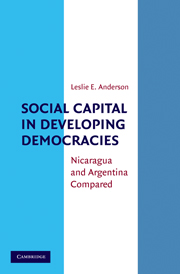Book contents
- Frontmatter
- Contents
- Preface
- 1 An Introduction
- PART I CREATING SOCIAL CAPITAL
- People I Have Known: The Human Face of Popular Politics
- 2 Creating “We”: Sandinismo and Bridging Social Capital
- 3 Creating “Us” and “Them”: Peronism and Bonding Social Capital
- PART II AN EMPIRICAL EXAMINATION OF THE ARGUMENT
- PART III MAKING DEMOCRACY WORK WITHOUT SOCIAL CAPITAL: INSTITUTIONAL CAPITAL
- 8 Conclusion
- Appendix
- Works Cited
- Index
2 - Creating “We”: Sandinismo and Bridging Social Capital
Published online by Cambridge University Press: 05 June 2012
- Frontmatter
- Contents
- Preface
- 1 An Introduction
- PART I CREATING SOCIAL CAPITAL
- People I Have Known: The Human Face of Popular Politics
- 2 Creating “We”: Sandinismo and Bridging Social Capital
- 3 Creating “Us” and “Them”: Peronism and Bonding Social Capital
- PART II AN EMPIRICAL EXAMINATION OF THE ARGUMENT
- PART III MAKING DEMOCRACY WORK WITHOUT SOCIAL CAPITAL: INSTITUTIONAL CAPITAL
- 8 Conclusion
- Appendix
- Works Cited
- Index
Summary
And what the hell do I care if the banks reduce their interest rates by one and one half points?
Eduardo Mazo, Autorizado a VivirLook at this cross! … I am not a communist, as Somoza calls all who fight against his government. I am a Catholic and a Sandinista.
Nicaraguan revolutionary from the barricades of Estelí, 1978We did not invent the fundamental elements of our liberation ourselves. The vanguard gathered these ideas from Sandino … We found political, military, ideological, and moral elements in our people, in our own history.
Humberto Ortega SaavedraSandinismo was fundamentally a movement of the poorest of the poor, many of whom did not even have jobs, much less labor unions. It was born out of landlessness, exploitative agro-export capitalism, and urban squalor. Although most Sandinistas were the lowest-income members of one of the poorest Latin American nations, Sandinismo was also a movement that joined together like-minded opponents of dictatorship who themselves came from many different walks of life. It was a movement deeply grounded in and aware of mainstream currents of political thinking and economic interdependence worldwide. Its leaders and thinkers exhibited profound awareness of the causes and consequences of wealth and poverty, even as many of its followers knew they were excluded from wealth and participation in the global economy.
Although Nicaragua is a poor nation lacking extensive natural resources, a vast market, or a strong economy, it benefits from its geographical location near the United States and at the heart of Latin America.
- Type
- Chapter
- Information
- Social Capital in Developing DemocraciesNicaragua and Argentina Compared, pp. 31 - 67Publisher: Cambridge University PressPrint publication year: 2010

